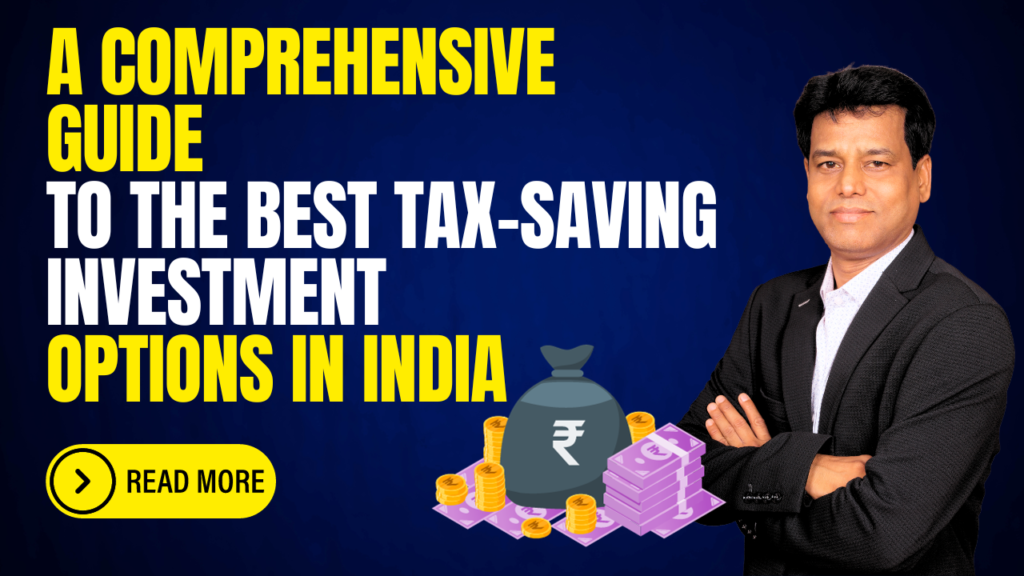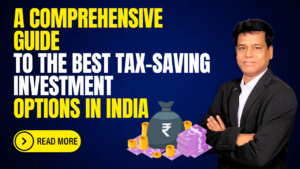Discover the top tax-saving investment options in India that can help individuals reduce tax liabilities while maximising wealth creation. Learn about popular investment instruments, their features, benefits, and factors to consider when choosing the right option for your financial goals.
Investing in the Best Tax-Saving Investment Options in India is an essential part of financial planning for individuals in the country. With a plethora of investment choices available, it can be overwhelming to select the most suitable options that offer tax benefits and optimal returns. In this comprehensive guide, we will explore the top tax-saving investment options in India, delve into their unique features and advantages, and provide valuable insights on factors to consider for aligning investments with your financial goals.
The Importance of Tax-Saving Investments:
Tax-saving investments play a vital role in effective financial planning. They not only help individuals reduce their tax liability but also offer potential avenues for wealth creation. By selecting the right investment options, individuals can not only save taxes but also capitalise on long-term financial growth through compounding. Additionally, tax-saving investments provide diversification opportunities to mitigate risk and contribute to the achievement of various financial goals, such as retirement planning, education expenses, and purchasing property.
Types of Tax-Saving Investment Options:
India offers a wide range of tax-saving investment options. Let’s explore some of the most popular choices:
1. Traditional Investment Options:
Traditional options such as Employee Provident Fund (EPF), Public Provident Fund (PPF), and National Savings Certificates (NSC) provide secure investment avenues with fixed returns. These options offer tax benefits under Section 80C of the Income Tax Act and come with specific lock-in periods.
2. Equity-Linked Savings Scheme (ELSS):
ELSS is a type of mutual fund that invests primarily in equity and equity-related instruments. It offers the potential for higher returns and tax benefits under Section 80C. ELSS has the shortest lock-in period of three years among all tax-saving investment options.
3. Public Provident Fund (PPF):
PPF, a long-term investment option backed by the Indian government, provides tax benefits under Section 80C. With a lock-in period of 15 years, PPF ensures stable returns and is widely favoured for long-term savings.
4. National Pension Scheme (NPS):
NPS is specifically designed for retirement planning and offers tax benefits under Section 80CCD of the Income Tax Act. It allows individuals to choose between equity, debt, and government securities for investment and comes with a lock-in period until retirement age.
5. Unit Linked Insurance Plans (ULIPs):
ULIPs combine insurance and investment components, providing tax benefits under Section 80C. They offer investment opportunities in both equity and debt funds and provide life insurance coverage alongside potential returns.
Comparison of Tax-Saving Investment Options:
To make an informed decision, it’s crucial to compare various factors among tax-saving investment options. Here’s a brief comparison:
| | | |
| Investment Option | Returns | Risk | Lock-in Period | Tax Implications |
| Traditional options | Fixed returns | Low | Varies (e.g., 15 years for PPF) | Taxable interest income |
| ELSS | Market-linked returns | High | 3 years | 10% tax on LTCG above 1 lakh |
| NPS | Market-linked returns | Moderate to High | Until retirement age | Taxable partial withdrawals and annuity payout |
| ULIPs | Market-linked returns | Moderate to High | 5 years | Tax-exempt maturity proceeds |
Factors to Consider When Choosing Tax-Saving Investments:
When selecting tax-saving investment options, it’s important to consider the following factors:
1. Risk Tolerance: Assess your risk tolerance and choose investment options accordingly, as traditional options offer more stability, while market-linked options involve higher risks.
2. Investment Goals: Align your investment goals with the appropriate investment options. Short-term goals may benefit from traditional options, while long-term goals can leverage market-linked options for potential higher returns.
3. Time Horizon: Consider the investment’s lock-in period and choose an option that aligns with your desired investment timeframe.
4. Liquidity: Evaluate your liquidity needs and select investment options that provide the required level of liquidity without compromising tax benefits.
Tips for Effective Tax-Saving Investments:
1. Diversification: Diversify your tax-saving investments across different asset classes to minimise risk and optimise returns.
2. Regular Review: Periodically review your investment portfolio to ensure it aligns with your goals and risk tolerance. Rebalance your portfolio as necessary.
3. Long-Term Perspective: Maintain a long-term investment perspective to leverage the power of compounding and navigate short-term market fluctuations.
4. Stay Informed: Stay updated with tax laws and regulations to make informed investment decisions. Seek professional advice when needed.
Conclusion:
Selecting the best tax-saving investment options in India is a crucial aspect of financial planning. By understanding the various investment choices, considering factors such as risk, returns, lock-in periods, and tax implications, individuals can make well-informed decisions aligned with their financial goals. Regular review, diversification, and staying informed are key to maximising the effectiveness of tax-saving investments. With careful consideration and professional guidance, individuals can optimise their tax-saving strategies and pave the way for long-term financial growth.
Unlocking the Potential of Tax-Saving Investments for Financial Growth in India
In India, tax-saving investments are not just a smart financial move; they are a crucial element of sound financial planning. These investments not only help individuals reduce their tax liability but also provide opportunities for wealth creation. In this comprehensive guide, we’ll explore the top tax-saving investment options in India, their key features, and the factors to consider when aligning your investments with your financial goals.
Importance of Tax-Saving Investments:
Tax-saving investments are pivotal to effective financial planning in India. They serve a dual purpose – reducing tax burdens and facilitating wealth creation. By choosing the right investment options, individuals can not only save on taxes but also harness the power of compounding for long-term financial growth. These investments also offer diversification, helping to mitigate risks and achieve various financial objectives like retirement planning, education funding, and property acquisition.
Varieties of Tax-Saving Investment Options:
India provides a plethora of tax-saving investment options to choose from. Let’s delve into some of the most popular choices:
1.Traditional Investment Options:
Traditional avenues such as the Employee Provident Fund (EPF), Public Provident Fund (PPF), and National Savings Certificates (NSC) offer secure investments with fixed returns. They come with tax benefits under Section 80C of the Income Tax Act and specific lock-in periods.
2. Equity-Linked Savings Scheme (ELSS):
ELSS, a type of mutual fund primarily invested in equity and related instruments, offers potential for higher returns and tax benefits under Section 80C. It boasts the shortest lock-in period of just three years among all tax-saving investment options.
3. Public Provident Fund (PPF):
PPF, a long-term government-backed investment option, provides tax benefits under Section 80C. With a 15-year lock-in period, PPF ensures stable returns and is a preferred choice for long-term savings.
4. National Pension Scheme (NPS):
Tailored for retirement planning, NPS offers tax benefits under Section 80CCD of the Income Tax Act. Investors can choose between equity, debt, and government securities and have a lock-in period until retirement age.
5. Unit Linked Insurance Plans (ULIPs):
ULIPs combine insurance and investment components, offering tax benefits under Section 80C. They provide investment opportunities in both equity and debt funds, along with life insurance coverage.
Comparing Tax-Saving Investment Options:
To make informed decisions, it’s essential to compare key factors among tax-saving investment options:
| Investment Option | Returns | Risk | Lock-in Period | Tax Implications |
|——————-|———|——|—————-|——————-|
| Traditional Options | Fixed Returns | Low | Varies (e.g., 15 years for PPF) | Taxable Interest Income |
| ELSS | Market-Linked Returns | High | 3 years | 10% Tax on LTCG above 1 lakh |
| NPS | Market-Linked Returns | Moderate to High | Until Retirement Age | Taxable Partial Withdrawals and Annuity Payout |
| ULIPs | Market-Linked Returns | Moderate to High | 5 years | Tax-Exempt Maturity Proceeds |
Factors for Consideration in Tax-Saving Investments:
When selecting tax-saving investment options, take these factors into account:
1. Risk Tolerance: Assess your risk tolerance and choose investments accordingly. Traditional options offer stability, while market-linked options involve higher risks.
2. Investment Goals: Align your investment goals with suitable options. Traditional choices work well for short-term goals, while market-linked options offer potential for higher returns over the long term.
3. Time Horizon: Consider the lock-in period and choose an option that matches your investment timeframe.
4. Liquidity: Evaluate your liquidity needs and select investments that provide the required level of liquidity without sacrificing tax benefits.
Tips for Effective Tax-Saving Investments:
1. Diversification: Diversify your tax-saving investments across various asset classes to minimize risk and optimize returns.
2. Regular Review: Periodically review your investment portfolio to ensure it aligns with your goals and risk tolerance. Make adjustments as needed.
3. Long-Term Perspective: Maintain a long-term perspective to leverage compounding and navigate short-term market fluctuations.
4. Stay Informed: Stay updated on tax laws and regulations to make informed investment decisions. Seek professional advice when necessary.
Addressing Common Concerns: FAQs
Q: Is insurance necessary if I already have an emergency fund?
A: While an emergency fund is crucial, insurance provides a broader safety net for unexpected events, ensuring your financial stability isn’t compromised.
Q: Can insurance help with estate planning?
A: Absolutely. Life insurance can play a pivotal role in estate planning, facilitating the seamless transfer of assets to beneficiaries.
Q: Are there instances where insurance may not be necessary?
A: Dr. Samaddar suggests that insurance should align with individual circumstances. For instance, if you have ample savings to cover unforeseen expenses, insurance might play a lesser role.
Q: How can I determine the right insurance coverage?
A: Dr. Samaddar advises a comprehensive evaluation of your financial goals, responsibilities, and risk tolerance. Seeking professional guidance can help tailor coverage to your needs.
Q: Can insurance aid in tax planning?
A: Yes, certain insurance products offer tax advantages. For instance, contributions to retirement insurance plans can result in tax benefits.
Q: How does insurance contribute to a holistic financial plan?
A: Insurance complements a holistic financial strategy by providing protection against risks that can disrupt your financial goals. It ensures that unforeseen events don’t impede your progress.
Conclusion:
Choosing the best tax-saving investment options in India is a vital component of financial planning. By understanding the available choices, considering factors like risk, returns, lock-in periods, and tax implications, individuals can make well-informed decisions that align with their financial goals. Regular review, diversification, and staying informed are key to maximizing the effectiveness of tax-saving investments. With careful consideration and professional guidance, individuals can optimize their tax-saving strategies and pave the way for long-term financial growth.


